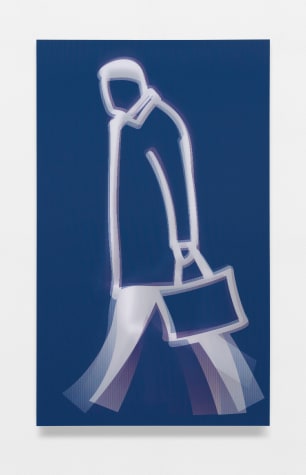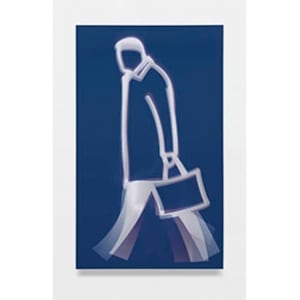Leather Bag (Series of Old Street Walkers), 2022
Acrylic panel mounted onto white acrylic
47 1/4 x 28 1/2 x 1 1/8 in
120 x 2.9 x 72.4 cm
120 x 2.9 x 72.4 cm
Edition 26/50
Copyright The Artist
%3Cdiv%20class%3D%22artist%22%3E%3Cstrong%3EJulian%20Opie%3C/strong%3E%3C/div%3E%0A%3Cdiv%20class%3D%22title%22%3E%3Cem%3ELeather%20Bag%20%28Series%20of%20Old%20Street%20Walkers%29%3C/em%3E%2C%202022%3C/div%3E%0A%3Cdiv%20class%3D%22medium%22%3EAcrylic%20panel%20mounted%20onto%20white%20acrylic%3C/div%3E%0A%3Cdiv%20class%3D%22dimensions%22%3E47%201/4%20x%2028%201/2%20x%201%201/8%20in%3Cbr%20/%3E%0A120%20x%202.9%20x%2072.4%20cm%3C/div%3E%0A%3Cdiv%20class%3D%22edition_details%22%3EEdition%2026/50%3C/div%3E
Julian Opie uses the walking person image as a kind of symbol, almost like Egyptian hieroglyphics. Seen from the side, the walking people reveal their shapes and their dignity—they are...
Julian Opie uses the walking person image as a kind of symbol, almost like Egyptian hieroglyphics. Seen from the side, the walking people reveal their shapes and their dignity—they are not posing or addressing the viewer, just passing by.
The first walking people Opie portrayed were family and friends, then people on the street and in local parks. His wife and daughter offered cash to passing strangers to model for half an hour. Opie next traveled to different countries—including Australia, India, Korea and the U.S.—to capture portraits that differed in terms of color, dress sense and mood.
The first walking people Opie portrayed were family and friends, then people on the street and in local parks. His wife and daughter offered cash to passing strangers to model for half an hour. Opie next traveled to different countries—including Australia, India, Korea and the U.S.—to capture portraits that differed in terms of color, dress sense and mood.
3
of 3




